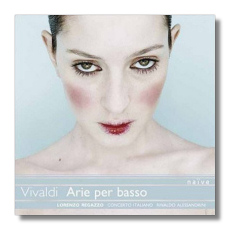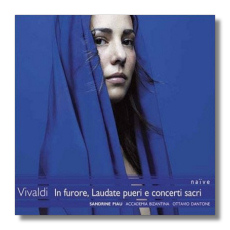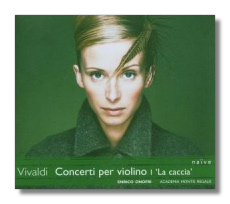
The Internet's Premier Classical Music Source
Related Links
- Vivaldi Reviews
- Latest Reviews
- More Reviews
-
By Composer
-
Collections
DVD & Blu-ray
Books
Concert Reviews
Articles/Interviews
Software
Audio
Search Amazon
Recommended Links
Site News
 CD Review
CD Review
Antonio Vivaldi

- Arias from:
- Armida al campo d'Egitto
- Tito Manlio
- Orlando furioso
- Semiramide
- Il Farnace
- La Silvia
- L'Adelaide
- L'Olimpiade
- Concerto in B Major for Strings, RV 162
Lorenzo Regazzo, bass
Concerto Italiano/Rinaldo Alessandrini
Naïve OP30415 DDD 62:07


- In furore iustissimae irae, RV 626
- Laudate pueri, RV 601
- Sinfonia "Al Santo Sepolcro," RV 169
- Concerto "per la Solennità di San Lorenzo," RV 286
- Concerto in D minor for Violin and Organ, RV 541
Ottavio Dantone, organ
Sandrine Piau, soprano
Marcello Gatti, flute
Stefano Montanari, violin
Accademia Bizantina
Naïve OP30416 DDD 62:56


- Violin Concerto in D Major "Grosso Mogul", RV 208
- Violin Concerto in G minor, RV 332
- Violin Concerto in D Major "L'Inquietudine", RV 234
- Violin Concerto in C minor "Il Sospetto", RV 199
- Violin Concerto in B Flat Major "La Caccia", RV 362
- Violin Concerto in E Major "Il Riposo", RV 270
Enrico Onofri, violin
Academia Montis Regalis
Naïve OP30417 DDD 55:36
Here are three more invigorating volumes in Naïve/Opus 111's ongoing series of music by Vivaldi – specifically, manuscripts located in the National University Library in Turin. Frédéric Delaméa's notes to the "Arie per basso" disc argue that Vivaldi, more than many of his contemporaries, had a particular appreciation for the bass voice, and that he had a gift for showing it off to its best advantage. Indeed, if one looks at Vivaldi's operas and other vocal works, arias and scenes for bass are more frequent and more refined than in most works written in the first four decades of the 1700s. For Vivaldi, the bass could be a lover, a warrior, a shepherd, a ruler, a buffoon, or any number of things. The arias on this CD demonstrate the range of personalities and musical styles adopted by Vivaldi's basses. What this means is that this CD is anything but monotonous, which is more than one can say about many recital discs! Vivaldi once was criticized for repetitiousness, but I find that almost every new Vivaldi CD that comes my way brings fresh and happy surprises!
The highlight among highlights is an extended aria -10:46, not counting the recitative and the orchestral introduction – marked Larghetto from the opera Il Farnace. In this aria ("Gelido in ogni vena"), a father sings that he feels the blood running cold in his every vein because he is responsible for the unjust murder of his son. Using poignant dissonance and restraint, Vivaldi makes time stand still through the utter horror of it all.
Bass Lorenzo Regazzo was born in Venice. This probably doesn't help him sing Vivaldi, but it surely doesn't hurt. As the music requires, he can lighten or darken his voice, and this helps him to step into the different roles that this disc demands of him. A good vocal actor, he further fleshes out the roles with an array of vocal inflections, but without exaggeration or coarseness. He is stylish and secure in even the most florid passages, and he sings Farnace's aria d'ombra with the requisite pathos. Regazzo's broad musical training comes in handy where music has been lost or has come down to us in various states of authenticity: on this CD, he's even credited with "reconstructing" the brief recitative that precedes the aria from L'Adelaide. (Alessandrini, always a lively and sensitive conductor, and Delaméa receive credit for other reconstruction efforts on this CD.)
Why, you might wonder after reading the headnote, has a concerto for strings been included among all these bass arias? It's not just to give Signor Regazzo a rest! It turns out that the aria "Fiume, che torbido" from La Silvia shares thematic material with the first movement of RV 162; the inclusion of both allows the listeners to hear how Vivaldi – like other Baroque composer including Bach and Handel, mind you – recycled his ideas. (This was not only acceptable, but expected at the time.)
All the Italian texts have been included, with English translations. Delaméa's informative essay is complemented by a few well-chosen words from Regazzo as well. With fine engineering, this is a release that will give any Vivaldian pleasure.
The second disc contains music that fulfilled "semi-liturgical" purposes; it deals with sacred matters, but not necessarily in the context of a formal Mass. The text of the motet In furore iustissimae irae describes God's righteous anger and His forgiveness of sins, but the music would work just as well if the soprano were singing about wanting her faithless lover to be struck by lightning, or about a storm that ravages the vineyards. In furore is a florid showpiece for soprano, two violins, viola, and double bass. It has been recorded several times by singers adept at Baroque coloratura, including (most recently) Patrizia Ciofi with Fabio Biondi and Europa Galante (Virgin Veritas). Like Ciofi, Piau has both the high notes and the agility required for this motet. The precision of her delivery is almost mechanical. That's not to say that her singing is lacking in life – it's just hard to believe, at times, that it's coming out of a human being. Her rather white and vibrato-less tone strengthens that impression. In the vesper psalm Laudate pueri, the soprano – accompanied by flute, two violins, viola, and double bass – catalogs praises to God. Here, as the text is less vehement, Piau's singing more yielding, and so one's enjoyment of her performance is more complete.
There are four surviving concerti for violin and organ, of which two are arrangements of other works. RV 541 appears to be an original work, however. The combination of violin and organ is piquant. Musically, this concerto is not unusually distinguished, but the novelty of instrumentation sees the listener through. Montanari and Dantone play it like the excellent Vivaldians they are.
The Sinfonia "Al Santo Sepolcro," scored for strings, is in two short movements, of which the first is marked "Adagio molto." Given its title ("at the holy sepulchre"), its scoring, and its brevity, Vivaldi probably intended this music for use during Holy Week, perhaps to accompany a specific liturgical action. Despite its brevity, this Sinfonia makes a strong impact because of the expressive intensity Vivaldi packs into it. The Concerto "per la Solennità di San Lorenzo" is almost as well-known. (It is not certain to which saint Vivaldi was referring in his title, as there is more than one Lorenzo.) In contrast to In furore, this time around Vivaldi eschews brilliant writing for the soloist in all but the last movement. Again, the performances are polished and historically informed, and the engineering and booklet notes complement the excellence of the performances.
With the third disc, we have the first volume – the first of many, no doubt! – of violin concertos. As if to give the lie to the old canard that Vivaldi wrote the same concerto five hundred times, Enrico Onofri's selection of six of them teems with variety. He plays them with variety too. Most (all?) of these concertos have been recorded before, but Onofri's performances give them a fresh coat of paint. Perhaps it would be better, though, to say that Onofri scrapes off centuries of well-intentioned varnish, which has led to the darkening of Vivaldi's brilliant colors. One of the most charming examples of Vivaldi's light touch is in "Il riposo," a musical depiction of sleep. In the concerto's first movement Vivaldi asks the harpsichord to be silent and all the strings to be muted. (In the booklet notes, Onofri relates that he went so far as to record this concerto "at dead of night to underline its dreamlike, mysterious aspect.") A similarly intimate and graceful example of Vivaldi's imagination and Onofri's sensitivity comes in the middle movement of "La Caccia," where the violin is gently supported by the plucking of an archlute. (This concerto is a close cousin of the "Autumn" concerto from The Four Seasons.) The bliss of "Il riposo" (Sleep) is well-earned, after the stress of "Il sospetto" (Suspicion) and "L'Inquietudine" (Restlessness); again Vivaldi finds musical equivalents for these mental states. With "Grosso Mogul," we are not quite sure of who (or what) Vivaldi was thinking when he composed this concerto – the mostly likely candidates are Turks or Indians. The first movement of this concerto bristles and blusters with warlike purpose, and Onofri slashes away at it most fearfully. The second movement contains references to gypsy music – a bit of geographical confusion here! Onofri must have sprinkled paprika on his bow before recording this movement, because he definitely has captured the mannerisms of gypsy violinists. Vivaldi in Budapest, anyone? This is great music, then, and the fizzing performances spill over with personality.
Copyright © 2006, Raymond Tuttle




















